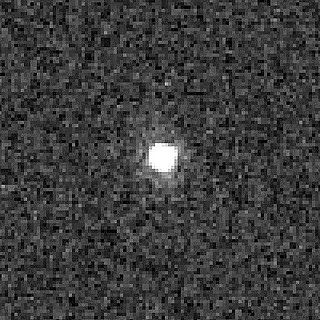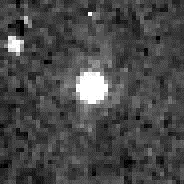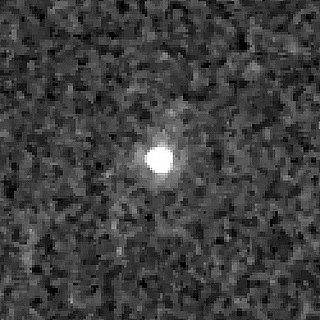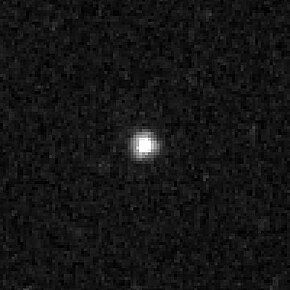(15874) 1996 TL66, provisional designation 1996 TL66, is a trans-Neptunian object of the scattered disc orbiting in the outermost region of the Solar System.

(90568) 2004 GV9 is a trans-Neptunian object that was discovered on April 13, 2004 by NEAT. It has been listed as a cubewano by the Minor Planet Center. It was discovered on 13 April 2004 by NEAT. It has been observed forty-seven times, with precovery images back to 1954. The object has an orbital period of 273.88 years. Its maximum possible distance from the Sun (aphelion) is 45.62 AU, and its closest (perihelion) is 38.7 AU, and currently 39.7 AU from the sun. It has an inclination of 21.9718, and eccentricity of 0.082.
(84719) 2002 VR128, also written (84719) 2002 VR128, is a trans-Neptunian object (TNO). It was discovered in 2002 by Michael Brown and Chad Trujillo. The object is a plutino, an object in 2:3 orbital resonance with Neptune.

(55565) 2002 AW197 is a classical, non-resonant trans-Neptunian object from the Kuiper belt in the outermost region of the Solar System, also known as a cubewano. With a likely diameter of at least 700 kilometers (430 miles), it is approximately tied with 2002 MS4 and 2013 FY27 (to within measurement uncertainties) as the largest unnamed object in the Solar System. It was discovered at Palomar Observatory in 2002.
(119070) 2001 KP77, provisional designation:2001 KP77, is a resonant trans-Neptunian object in the Kuiper belt, a circumstellar disc located in the outermost region of the Solar System. It was discovered on 23 May 2001, by American astronomer Marc Buie at the Cerro Tololo Observatory in Chile. The object is locked in a 4:7 orbital resonance with Neptune. It has a red surface color and measures approximately 176 kilometers (110 miles) in diameter. As of 2021, it has not been named.

(208996) 2003 AZ84 is a trans-Neptunian object with a possible moon located in the outer regions of the Solar System. It is approximately 940 kilometers across its longest axis, as it has an elongated shape. It belongs to the plutinos – a group of minor planets named after its largest member Pluto – as it orbits in a 2:3 resonance with Neptune in the Kuiper belt. It is the third-largest known plutino, after Pluto and Orcus. It was discovered on 13 January 2003, by American astronomers Chad Trujillo and Michael Brown during the NEAT survey using the Samuel Oschin telescope at Palomar Observatory.

(145452) 2005 RN43, also written as (145452) 2005 RN43, is a classical Kuiper belt object. It has an estimated diameter of 679+55
−73 km. It was discovered by Andrew Becker, Andrew Puckett and Jeremy Kubica on 10 September 2005 at Apache Point Observatory in Sunspot, New Mexico. Brown estimates that it is possibly a dwarf planet.

(84922) 2003 VS2 is a trans-Neptunian object discovered by the Near Earth Asteroid Tracking program on 14 November 2003. Like Pluto, it is in a 2:3 orbital resonance with Neptune and is thus a plutino. Analysis of light-curve suggests that it is not a dwarf planet.

(15875) 1996 TP66, provisional designation 1996 TP66, is a resonant trans-Neptunian object of the plutino population, located in the outermost region of the Solar System, approximately 154 kilometers (96 miles) in diameter. It was discovered on 11 October 1996, by astronomers Jane Luu, David C. Jewitt and Chad Trujillo at the Mauna Kea Observatories, Hawaii, in the United States. The very reddish RR-type with a highly eccentric orbit has been near its perihelion around the time of its discovery. This minor planet was numbered in 2000 and has since not been named. It is probably not a dwarf planet candidate.

(42301) 2001 UR163, prov. designation: 2001 UR163, is a resonant trans-Neptunian object and possible dwarf planet located in the outermost region of the Solar System. The object measures approximately 352 kilometers (220 miles) in diameter with a high albedo and stays in an uncommon orbital resonance (4:9) with Neptune. It was discovered on 21 October 2001 by astronomers of the Deep Ecliptic Survey program at Kitt Peak National Observatory near Tucson, Arizona, United States. As of 2021, it has not been named.
(35671) 1998 SN165, prov. designation: 1998 SN165, is a trans-Neptunian object from the Kuiper belt located in the outermost region of the Solar System. It was discovered on 23 September 1998, by American astronomer Arianna Gleason at the Kitt Peak National Observatory near Tucson, Arizona. The cold classical Kuiper belt object is a dwarf planet candidate, as it measures approximately 400 kilometers (250 miles) in diameter. It has a grey-blue color (BB) and a rotation period of 8.8 hours. As of 2021, it has not been named.
(120348) 2004 TY364, provisionally known as 2004 TY364, is a trans-Neptunian object. It is an inner classical Kuiper belt object in the definition by Gladman, Marsden, and Van Laerhoven (e<0.24). Its inclination of almost 25 degrees disqualifies it as such in Marc Buie's definition. It is also not listed as a scattered disc object by the Minor Planet Center. It was discovered by Michael E. Brown, Chad Trujillo and David L. Rabinowitz on October 3, 2004 at the Palomar Observatory.

(455502) 2003 UZ413, also written as 2003 UZ413, is a trans-Neptunian object (TNO) with an absolute magnitude of 4.38. It is in a 2:3 orbital resonance with Neptune, thus it is classified as a plutino. There are indications it may be dense enough to be a dwarf planet. It was given the minor planet number 455502 on 22 February 2016.
(303775) 2005 QU182, also written as (303775) 2005 QU182, is a trans-Neptunian object with a bright absolute magnitude of ca. 3.6.

(612533) 2002 XV93, also written as 2002 XV93, is a trans-Neptunian object (TNO) with an absolute magnitude of 5.4. A 2:3 orbital resonance with Neptune makes it a plutino.
(144897) 2004 UX10 is a Kuiper-belt object. It has a diameter of about 360 kilometres (220 mi) and was discovered by Andrew Becker, Andrew Puckett and Jeremy Kubica on 20 October 2004 at Apache Point Observatory in Sunspot, New Mexico. The object is classified as a cubewano. It is near a 2:3 resonance with Neptune.
(307463) 2002 VU130, prov. designation: 2002 VU130, is a trans-Neptunian object, located in the circumstellar disc of the Kuiper belt in the outermost region of the Solar System. The resonant trans-Neptunian object belongs to the population of plutinos and measures approximately 253 kilometers (160 miles) in diameter. It was discovered on 7 November 2002, by American astronomer Marc Buie at the Kitt Peak Observatory near Tucson, Arizona. The object has not been named yet.
2006 HJ123 (also written 2006 HJ123) is a trans-Neptunian object (TNO). It was discovered in 2006 by Marc W. Buie. The object is a plutino (in 2:3 resonance with Neptune).
(175113) 2004 PF115 (also written 2004 PF115) is a trans-Neptunian object (TNO). It was discovered in 2006 by M. Brown, C. Trujillo, D. Rabinowitz. The object is classified as a possible plutino.

(82158) 2001 FP185, provisional designation 2001 FP185, is a highly eccentric trans-Neptunian object from the scattered disc in the outermost part of the Solar System, approximately 330 kilometers in diameter. It was discovered on 26 March 2001, by American astronomer Marc Buie at Kitt Peak National Observatory in Arizona, United States.










